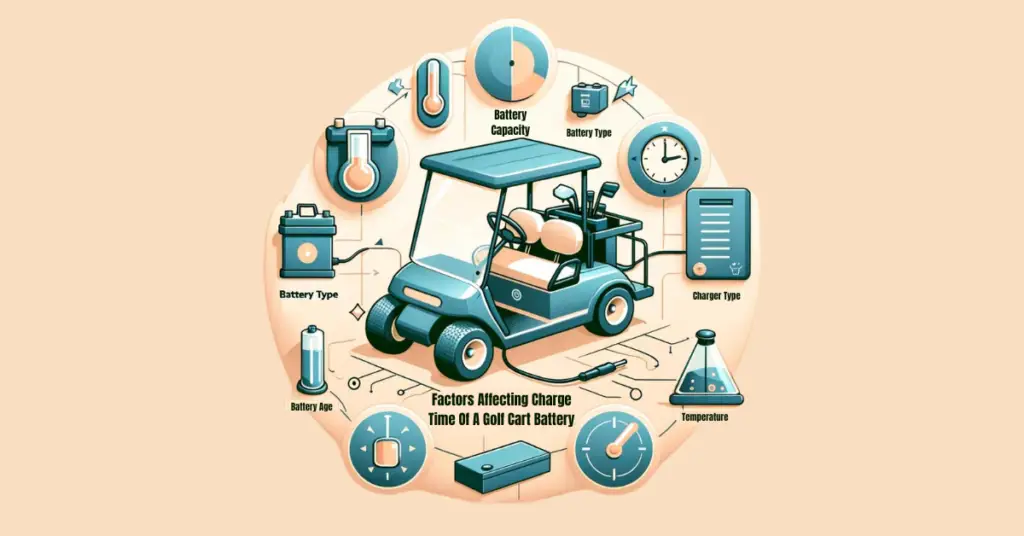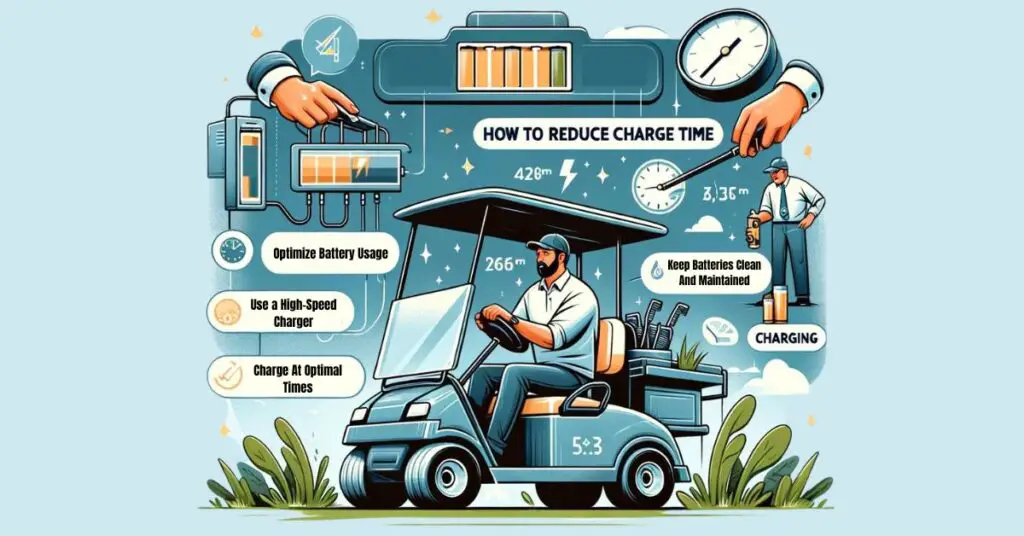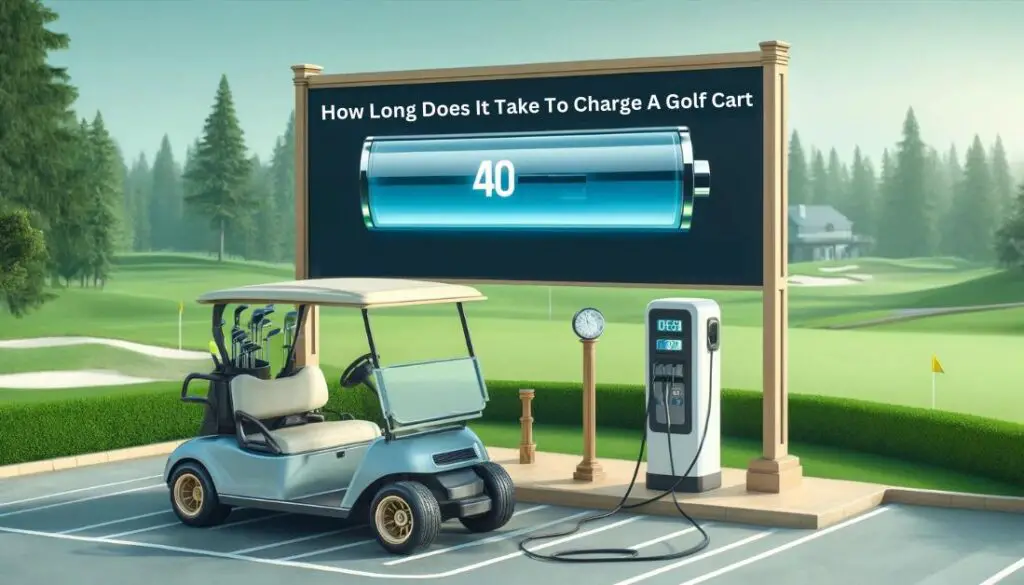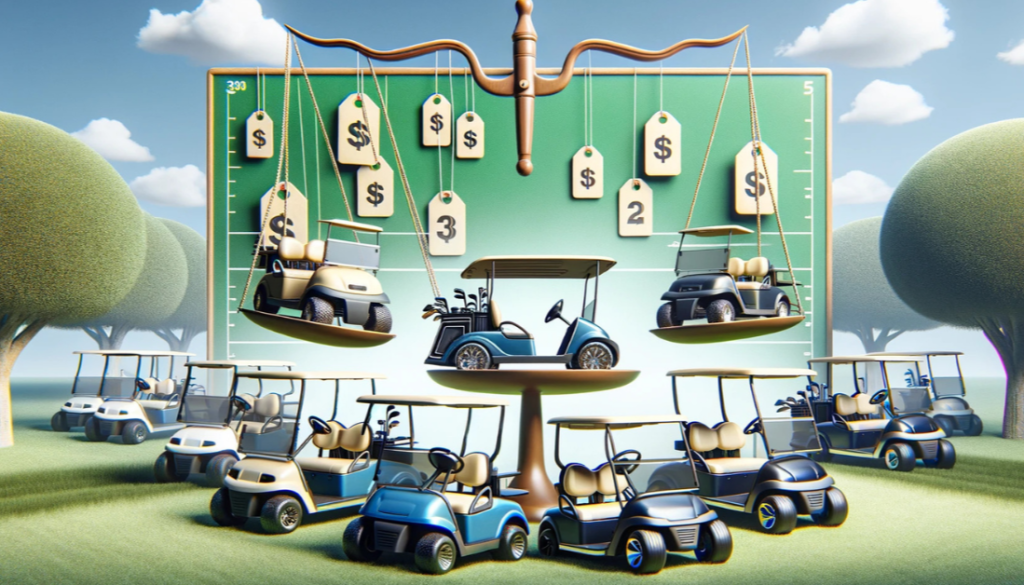Consider the excitement of a day on the golf course, with the fresh air, rich foliage, and expectation of a great game ahead. However, looking at your golf cart’s low battery display quickly reduces your energy.
The frustration starts when you realize you must wait for your cart to recharge before hitting the buttons. Every golfer fears this scenario, so don’t worry! I’m here to help answer your concerns and shed light on the often complicated procedure of golf cart charging.
Toghater, we will go deep into this complex subject of “how long does it take to charge a golf cart”, figure out some main factors that affect charging time, and also we will also give some golf cart battery charging tips for improving your charging experience and reduce charging time. So, grab your clubs, and let’s dive deep into the journey to spend more time on the fairway and less time plugged into the charger.
Table of Contents
ToggleHow Long Does It Take To Charge A Golf Cart
Normal golf cart chargers might take between 8 and 12 hours to fully charge. But some factors impact charging golf cart time like battery type, charge state, charger capacity, and method. Some newer models with fast-charging capabilities may achieve full charge in a shorter amount of time.
Additionally, factors like temperature and battery state can influence charging durations, as we’ll explore further. This allows you to accurately estimate golf cart charges times and prevent mid-round battery blues.
Factors Affecting Charge Time Of A Golf Cart Battery

We discussed the 8-12 hour charging time for a lead-acid battery, but as I always tell my fellow golfers, there’s more to the story! Several factors can influence how long it takes to get your cart back in action. Let’s break into these major factors:
Battery Type
The type of battery your golf cart utilizes has a considerable impact on its charging duration. Most golf carts use either lead-acid or lithium-ion batteries. Lead-acid batteries take longer to charge (8 to 12 hours) than lithium-ion batteries due to their lower energy density and differing charging properties.
Also Read: Explore our details comparison on 6 Volt Vs 8 Volt Batteries and select the right battery for your cart
Battery Capacity
The capacity of your golf cart battery directly impacts charging time, measured in ampere-hours (Ah). A larger capacity battery takes longer to charge than a lower capacity one since it requires more energy to reach full charge. It is critical to consider battery capacity when predicting charging time to ensure you are prepared for the wait.
Charger Type
The type of golf cart battery charger you select might have a major effect on your golf cart’s charging time. Standard chargers usually take longer to charge than high-speed or quick chargers. The good news is that fast chargers are becoming more popular. These chargers can shorten charging time by up to 50%, which is ideal for golfers who require a speedy turnaround.
Battery Age
Unfortunately, batteries do not live forever, like our favorite clubs. As golf cart batteries age, their charging efficiency may decrease, resulting in longer charging times. This is especially true for lead-acid batteries, which can sulfate and degrade over time. Regular maintenance and good care can help extend the battery life and reduce the influence of age on charging times.
Temperature
When your golf cart battery is charged the temperature of the environment can also impact charging time. To maximize charging speed and performance, charge golf cart batteries at moderate temperatures. Because extreme temperatures(both hot and cold) can slow down the charging golf cart battery process and lower their performance.
How To Reduce Charge Time

To ensure you spend more time on the course and less time waiting for your golf cart to charge, there are numerous ways you may use to reduce charge time effectively:
Optimize Battery Usage
Keep track of your battery usage during your rounds. Avoid excessive acceleration and braking, and restrict the use of accessories such as lights and speakers to save golf cart battery charging for longer travel.
Use a High-Speed Charger
Compared to Standard chargers the high-speed charger can significantly reduce charge time. While maintaining battery health these chargers can provide additional power to the battery, allowing for faster charging.
Charge At Optimal Times
Charging a golf cart at off-peak hours, when electricity demand is lower, may result in faster charging times. Additionally, scheduling charging sessions when the battery is just partially exhausted might shorten overall charge time.
Keep Batteries Clean And Maintained
You can increase the golf cart’s battery efficiency and charging ability through regular cleaning and maintenance. Inspect for corrosion on terminals, enough water levels in lead-acid batteries, and any indication of damage or wear.
Monitor Battery Temperature
To improve charging speed and efficiency, charge your golf cart battery at, a moderate temperature. Avoid charging in severe temperatures, as this could slow the charging process and reduce overall battery performance.
You can easily decrease your charging duration by using these techniques and increase your time on the course, assuring a fun and carefree experience each time you hit the links.
Conclusion
For Maximing your time on the course it’s important to know how long it takes to take to charge a golf cart. You can estimate your cart charging time by considering factors like battery type, capacity, charger type, battery age, and temperature, and plan your trips appropriately.
Furthermore, techniques for reducing charge time, including optimizing battery usage, using high-speed charger’s, charging at appropriate times, maintaining batteries, and monitoring temperature, can improve your golfing experience.
With these ideas and habits, you’ll spend less time waiting at the charger and more time playing your favorite game. So keep these suggestions in mind, and may your future rounds be filled with smooth rides and unforgettable shots on the fairway.
FAQ's
Two main ways to know if your golf cart is fully charged:
- Charger Indicator: Most automatic golf cart chargers have a built-in light that will change color or turn off entirely when charging is complete.
- Battery Voltage (for lead-acid batteries only): Fully-charged lead-acid battery typically reads around 12.6 volts. You can measure the battery voltage to determine the charge level. Remember, this method needs a voltmeter and some knowledge of safe battery handling. For precise readings, consult your golf cart’s manual.
No, Keeping the golf cart plugged in all the time is not recommended. For preventing overcharging, the latest golf cart chargers are smart they automatically turn off when the battery achieves full charge.
However, this is only a quick estimate. With good battery health conditions and a standard lead-acid battery an electric golf cart may drive 15-20 miles on a single charge. If you want to discover your cart’s actual range, check your owner’s guide or the manufacturer’s website for detailed information on your battery ability and cart’s model.
There are two main reasons why golf carts take longer to charge compared to some electric vehicles particularly those with lead-acid battery’s:
- Battery Chemistry: To store and release energy Lead-acid batteries rely on a slower chemical reaction. Compared to lithium-ion batteries this process is slower, used in some electric cars, and translates to longer charging times.
- Charging Method: Normal golf cart chargers provide the battery with a constant current. It is a slower then fast-charging technology used in some electric carts and also it’s also safe and reliable.
The voltage can’t impact your charging time. The main considerations are the capacity of the battery and charger type. Regardless of voltage, a higher capacity battery takes a longer time to change than a smaller battery.
Yes, If you use your cart on a daily base then you can charge your golf cart every night. This avoids deep discharge and keeps your battery in good condition for the longest life. Even a brief top-off charge following use is good.



